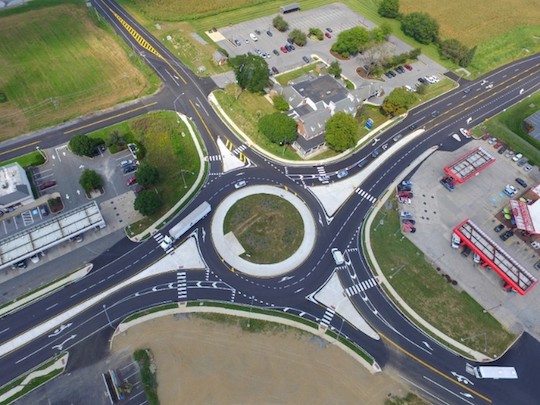The Pennsylvania Department of Transportation announced today that according to department data, fatalities, injuries, and crashes decreased overall after intersections at 33 locations were replaced with 36 roundabouts.
“We continue to see that Pennsylvania’s roundabouts save lives and reduce crash severity,” said PennDOT Secretary Yassmin Gramian. “While they aren’t the right option in every intersection, we’re pleased that they help to make our roadways safer.”
PennDOT recently reviewed data for 36 roundabouts on state routes at intersections that were previously stop- or signal-controlled. These roundabouts were selected based on having at least three years of crash data available before and after the roundabouts were built. This accounts for a total of 387 before years and 220 after years of data.
Department data from 2002 through 2021 – based on police-submitted crash reports and weighted based on the number of before and after years, but not for increases in traffic volume – shows the following:
- Suspected serious injuries were reduced by 76 percent;
- Suspected minor injuries were reduced by 22 percent;
- Possible/unknown severity injuries were reduced by 70 percent; and
- Total number of crashes decreased by 9 percent.
Unfortunately, there was one fatality in one of the roundabouts; however, there were a combined three fatalities prior to the installation of roundabouts at the 33 locations.
In addition to the 36 roundabouts meeting the selection criteria, 38 other roundabouts have been built on state routes, with 16 more under construction and 15 in the final design.
The roundabouts included in the review from Southern Chester County were Route 82 (Doe Run Road) and Unionville Road, which opened in 2005; and Route 52 (Lenape Road), S. Wawaset Road and Lenape.
A roundabout in Delaware County at Route 320 (Chester Road), Rutgers Avenue and Fieldhouse Lane, which opened in 2014, was also included.
Roundabouts are frequently installed to address intersections with safety issues but may also be installed to improve traffic flow as well as other reasons such as traffic calming and to facilitate pedestrian mobility.
Although roundabouts are safer and typically more efficient than traditional signalized intersections, they may not always be the best option due to topography or other reasons, such as property impacts, capacity issues and proximity to other intersections.
Roundabouts are recognized by the Pennsylvania State Transportation Innovation Council (STIC) as an innovation that has become standard practice within the transportation community.
To educate Pennsylvanians on how to navigate a roundabout, the department created a video on how to use both single and multi-lane roundabouts, whether in a vehicle, on a bicycle, or foot. The video can be accessed by visiting the roundabout page on PennDOT’s website or by visiting the department’s YouTube channel.





Comments